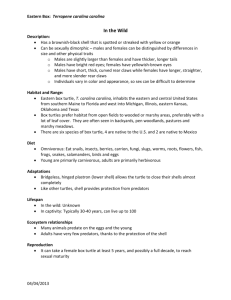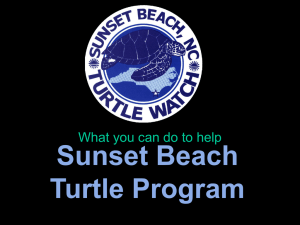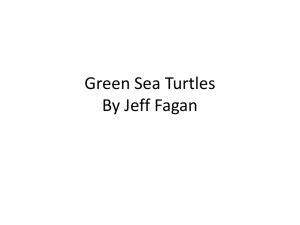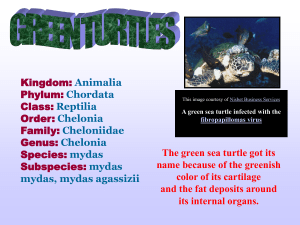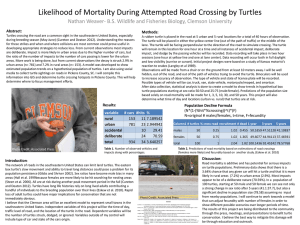Turtle Watch
advertisement
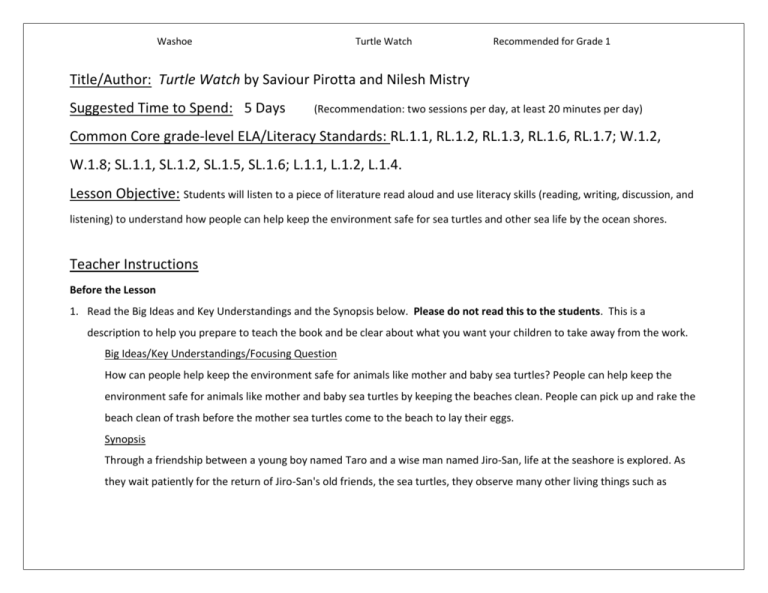
Washoe Turtle Watch Recommended for Grade 1 Title/Author: Turtle Watch by Saviour Pirotta and Nilesh Mistry Suggested Time to Spend: 5 Days (Recommendation: two sessions per day, at least 20 minutes per day) Common Core grade-level ELA/Literacy Standards: RL.1.1, RL.1.2, RL.1.3, RL.1.6, RL.1.7; W.1.2, W.1.8; SL.1.1, SL.1.2, SL.1.5, SL.1.6; L.1.1, L.1.2, L.1.4. Lesson Objective: Students will listen to a piece of literature read aloud and use literacy skills (reading, writing, discussion, and listening) to understand how people can help keep the environment safe for sea turtles and other sea life by the ocean shores. Teacher Instructions Before the Lesson 1. Read the Big Ideas and Key Understandings and the Synopsis below. Please do not read this to the students. This is a description to help you prepare to teach the book and be clear about what you want your children to take away from the work. Big Ideas/Key Understandings/Focusing Question How can people help keep the environment safe for animals like mother and baby sea turtles? People can help keep the environment safe for animals like mother and baby sea turtles by keeping the beaches clean. People can pick up and rake the beach clean of trash before the mother sea turtles come to the beach to lay their eggs. Synopsis Through a friendship between a young boy named Taro and a wise man named Jiro-San, life at the seashore is explored. As they wait patiently for the return of Jiro-San's old friends, the sea turtles, they observe many other living things such as Washoe Turtle Watch Recommended for Grade 1 dolphins, swordfish, and whales. Students will learn about sea turtles and how conservationists like Taro and Jiro-San help mother and baby sea turtles. 2. Go to the last page of the lesson and review “What Makes this Read-Aloud Complex.” This was created for you as part of the lesson and will give you guidance about what the lesson writers saw as the sources of complexity or key access points for this book. You will of course evaluate text complexity with your own students in mind, and make adjustments to the lesson pacing and even the suggested activities and questions. 3. Read the entire book, adding your own insights to the understandings identified. Also note the stopping points for the textinspired questions and activities. Hint: you may want to copy the questions vocabulary words and activities over onto sticky notes so they can be stuck to the right pages for each day’s questions and vocabulary work. The Lesson – Questions, Activities, and Tasks Questions/Activities/Vocabulary/Tasks FIRST READING: Read aloud the entire book (or chapter) with minimal interruptions. Stop to provide word meanings or clarify only when you know the majority of your students will be confused. SECOND READING: Throughout the reading, model and invite students to do gestures to match the actions in the story (listening to wind, riding waves, watching, etc.) Expected Outcome or Response (for each) The goal here is for students to enjoy the book, both writing and pictures, and to experience it as a whole. This will give them some context and sense of completion before they dive into examining the parts of the book more carefully. Washoe Turtle Watch Where does the story take place? Who are the main characters? What is the difference between Yuko and Taro’s opinion of Jiro-San? (p.2) What does it mean when Jiro-San says, “The wind is bringing me a message”? (p. 4) Jiro-San says, “My old friends are coming.” And Taro asks, “Who are your old friends?” Then Jiro-San replies, “You’ll see.” (p.4) Taro’s “heart sank.” Why does Taro’s heart sink? What does this expression mean? How do you know? (p. 6) Recommended for Grade 1 The story takes place on a beach and in a boat in the ocean of Japan. We know this because of the names of the characters and the dining room of Taro’s home. Adding –San to the end of Jiro’s name is a sign of respect in the Japanese language. Japan is not mentioned in the book but can be told directly to the students. The main characters are Jiro-San and Taro. Once students identify the main characters, start a T-chart of the characters’ traits (see example). Ask students: what words does the author use to describe Jiro-San? What words does the author use to describe Taro? There are many examples in the story that show Jiro-San’s wisdom, patience and kindness as well at Taro’s patience and growing wisdom. Continue to add to this chart through each day of rereading. Taro thought Jiro-San was a wise man while Yuko thought he was weird for sweeping the sand. Jiro-San uses this expression to explain that by sitting by the seashore and listening to the wind, he could tell if his “old friends” were going to return. This is where the expression “old friends” can be discussed with students. Jiro-San waits with anticipation to see if his turtles who return every year to lay their eggs will return or not. This is where Jiro-San demonstrates waiting patiently for the turtles. The expression “heart sank” means that Taro was worried that his sister was right. The author writes, “Yuko was right—maybe Jiro-San was weird.” (p. 6) There is broken glass and rubbish on the beach and Jiro-San’s friends know they will get hurt if they come to the beach. Jiro-San and Taro Washoe Turtle Watch Recommended for Grade 1 Why won’t Jiro-San’s friends come to the beach? (p.6) clean up the beach so that Jiro-San’s friends won’t get hurt. Look at the illustration on pages 7-8. How does Taro's family have their supper? What details in the illustrations help you to understand? Taro, Yuko and their mother sit on cushions on the floor. The table is low to the ground. The family kneels. They do not use chairs. They do not use forks, spoons or knives; instead they use chopsticks. They use bowls, saucers and cups or glasses. The family does not wear their shoes at dinner. This helps us to know that the story takes place in Japan.(p. 7-8) Jiro-San is the old man. (p. 9) On page 9, the author refers to the "old man". Who is the "old man"? (p. 9) On page 9, the author says that the dolphins are "riding the waves." What does this expression mean? What clues in the text help you to understand this expression? (p. 9) [use a gesture such as making an up-and-down wave motion to help scaffold & solidify students' understanding of the expression.] The dolphins are swimming on and under the waves. It is as if the waves are helping to carry them along like a bicycle helps to carry a person along. In the illustration, we can see the dolphins just at the water's surface. The illustrator shows us how they dive into and back out of the water. (p. 9) Taro asks, “Are they your old friends?” on this page (9) and on page 11, and 14. Students could be asked to echo read this phrase since it is a repeated phrase to support comprehension. What does Jiro-San bring out of the shed? (p. 11) Jiro-San brings an old boat and oars out of the shed. (p. 11) On page 11, Jiro-San says, "We've got company." What does Jiro-San mean? Who or what is the "company"? What clues helped you to figure this out? (p. 11) Students may need help to clarify that "We've got company," means "We have visitors." In the sentence that follows "We've got company," Taro watches as a whale and her young one come by. Think aloud or guide students to infer that the "company" refers to the visiting whales. (p. 11) Washoe Turtle Watch Recommended for Grade 1 Taro said, “Don’t be sad,” to Jiro-San. Why does Taro believe Jiro-San is sad? (p. 14) They have been waiting for the old friends for days and they have not come. Jiro-San says “They seem to be late this year. Perhaps they are not coming at all.” (p. 14) Where did Jiro-San’s old friend come from and what did the friend look like? (p. 16) Picture support shows that a turtle is coming from the water. “At last the children could see what it was – a turtle!” and it was a “dark shape moving…” and “It was huge and bobbed up and down on the water like an enormous cork” THIRD READ: Act out the actions of the turtles coming to the shore, digging the hole, covering the eggs, etc. Why is Taro happy? (p. 18) The beach is safe for the turtles to lay their eggs. (p. 18) Why was it important for Jiro-San to sweep the beach and how do you know? (p. 18) The sand needs to be clean for the turtles to lay their eggs in a nest in the sand. The turtles “started digging with her flippers,” and” laid …eggs in a nest” and “flung more sand over it with her front flippers.” (p. 18) In the sentence, “The three friends swept up all the litter dropped by the holiday-makers,” what do you think the word “litter” means? Who is the author talking about when he refers to the “holidaymakers”? Litter means garbage. Holiday-makers are when the author is referring to people who enjoy their free time at the beach. (p. 19) Students can demonstrate what the word litter means by throwing small pieces of paper on the floor and then discussing the importance of picking them up and placing them in the trash can. This is also a place to discuss by picking up the trash and glass on the seashore, it Washoe Turtle Watch Recommended for Grade 1 is making the beach safe for the turtles. How does the author let us know that it is important that the beach is clean and why? Why are the turtles coming now? What are clues the author gave you throughout the story? (p. 19) Why is it important for Taro to understand the word patient? How does patience apply to this story? What are they waiting for? (p. 19-20) Go back to p. 6 to take a picture walk and discuss the events such as the sweeping of the beach that led to the turtles laying their eggs in this location. Jiro-San is trying to explain to Taro that it might take some time before they discover what will happen next. He explains to Taro that there will be something to see, but they need to be patient. At the end of 8 weeks they discover the eggs hatched and the sand was filled with baby turtles. (p. 19-20) Why do you think Jiro-San wanted Taro and Yuko to meet him at dusk Jiro-San wanted Taro and Yuko to meet him at dusk because he knew and why did they need to sit quietly? What clue can you use from the the eggs would be hatching when the moon rose. Taro and Yuko text to figure out what dusk means? (p. 22) were instructed to sit quietly on the rocks so they could watch the sand begin to move as the turtles crawled out from below. A clue to use and identify the meaning of dusk is “as the moon rose”. (p.22) Compare how Yuko feels about Jiro-San at the beginning of the story. How did her opinion of him change? (p. 24) At the beginning of the story Yuko refers to Jiro-San as “weird”. At the end of the story she realizes he is not crazy after all and she discovers he is “old and wise and full of wonderful secrets”. (p.24) FOURTH READ AND BEYOND: Over one or two sessions, read aloud expository text on page 25, “About Sea Turtles” one paragraph at a time. Use the questions below (1-2 per paragraph) to prompt a discussion and deeper understanding of the text. Sentence stems are provided for each Teachers write Paragraph 1 sentence stems on chart paper. As students respond, teacher acts as a scribe to record students' responses below the sentence stem. Teacher tapes supporting picture(s) next to or near the sentence stem. Continue to read aloud Washoe Turtle Watch paragraph to help students reply in complete sentences. Write sentence stem followed by student replies on chart paper as you read and discuss the text. Photographs which support each paragraph are included. See paragraph number embedded with word or phrase that describes each picture. . Paragraph 1 Ask the students, “Describe what loggerhead turtles eat.” Sentence stem: “The diet of loggerhead turtles includes…” Ask students, “Why do loggerhead turtles and their relatives have a bony, outer shell?” Sentence stem: “Loggerhead turtles and their relatives have a bony, outer shell because…” Paragraph 2 Ask students, “When the weather is warm, what makes loggerhead turtles migrate to the seashore?” Sentence stem: “Loggerhead turtles migrate to the seashore to…” Recommended for Grade 1 one paragraph at a time, write sentence stem, tape on picture support, and record students' responses in this manner. These photographs, questions and responses may act as notes to which students can refer as they complete the culminating activities. Students respond within a range of language complexity according to their English language developmental level. Responses may include: “The diet of the loggerhead turtle includes sea grasses, crabs, shrimps, and shells,” or “The diet of the loggerhead turtle includes crabs,” or “Turtles eat shrimps.” Responses may include: “Loggerhead turtles and their relatives have a bony outer shell because it is like armor that protects them,” or “Loggerheads turtles have a shell that protects them,” or “Turtles have a shell to protect.” Responses may include: “Loggerhead turtles migrate to the seashore to mate and lay their eggs,” or “Loggerhead turtles migrate to lay their eggs,” or “Turtles lay eggs.” Paragraph 3 Ask students, “How many eggs does a mother turtle lay? Where Responses may include: “A mother turtle lays about 100 eggs in a bucket-sized pit in the sand.”or “A mother turtle lays about 100 eggs does she lay her eggs? in a pit that she digs with her flippers.” Sentence stem: “A mother turtle lays about ____eggs in….. Washoe Turtle Watch Ask students, “According to the author, what is one predator that threatens turtle eggs?” Sentence stem: “One predator that threatens turtle eggs is…” Paragraph 4 Ask students, “What does the mother turtle do after she lays the eggs?” Sentence stem: “After she lays the eggs, the mother turtle…” Paragraph 5 Ask students, “After two months, what happens to the eggs? What happens next?” Sentence stem: “After two months, the eggs…Next…” Paragraph 6 Ask students, “Tell about some of the loggerhead turtle’s enemies.” Sentence stem: “The loggerhead turtle’s enemies are…” Paragraph 7 Ask students, “ Are Jiro-San and Taro conservationists? Sentence stem: “Conservationists are…. Recommended for Grade 1 Responses may include: “One predator that threatens turtle eggs is the lizard,” or “One predator is the lizard.” Responses may include: “One predator that threatens turtle eggs is the (raccoon, lizard). “ Responses may include: “The mother turtle returns to the sea because she cannot survive long on land,” or “The mother turtle returns to the sea.” Responses may include: “After two months, the eggs hatch. Next, baby turtles scurry down to the water,” or “The eggs hatch. Next, baby turtles scurry down to the water. Responses may include: “The loggerhead turtle’s enemies are sharks which eat them and humans who make things out of their shells, catch them in nets,” or “The loggerhead turtle’s enemies are sharks and humans.” Responses may include: “Conservationists are people like Jiro-San and Taro because they cleaned the beach to help protect the turtles. Washoe Turtle Watch Recommended for Grade 1 FINAL DAY WITH THE BOOK - Culminating Task Using pictures and connecting words (transition words), the students sequentially retell the egg-laying and hatching events. Student: Beginning: Jiro-San and Taro play at the beach and discover interesting things under water. Middle: Jiro-San and Taro sweep the beach and wait for Jiro-San’s friends. End: The turtles come to the beach and lay their eggs. The eggs hatch baby turtles. Washoe Turtle Watch Recommended for Grade 1 Students explain how people help turtles and how their actions may harm turtles. Students sketch, write and discuss one positive impact and one negative impact using evidence from the text. Raking the beach and picking up garbage is good because glass and trash won’t hurt the turtles. When we litter our beaches turtles won’t come to lay eggs. Washoe Turtle Watch Recommended for Grade 1 Vocabulary These words merit less time and attention These words merit more time and attention (They are concrete and easy to explain, or describe events/ processes/ideas/concepts/experiences that are familiar to your students ) (They are abstract, have multiple meanings, and/or are a part of a large family of words with related meanings. These words are likely to describe events, ideas, processes or experiences that most of your student will be unfamiliar with) Washoe Turtle Watch Page 1 - rotten - decomposing or decaying Page 1 - seahorse - a fish with a grasping tail and long snout Page 1 - rock pool - a small pool of water left on the beach after the wave flows back into the sea Page 1 - crab - any crustacean having eyes on the short stalks and a short, broad, flat body Page 1 - sponges - an aquatic, marine animal of the phylum Porifera having a porous structure and an internal skeleton Page 7 - supper - the evening meal Page 11 - amazement - great astonishment, wonder, or surprise Page 11 - oar(s) - a long shaft with a blade at one end used for rowing Page 11 - flicked - to move with a sudden jerk or stroke Page 14 – snouts- the part of an animal's head protruding forward and including the nose and jaws; muzzle Page 16 - cork - the outer bark of an oak used for making stoppers for bottles Page 16 - bobbed - to move quickly up and down Page 16 - enormous - huge, immense Page 18 - scrambled - to climb or move quickly using one's hands and feet Page 18 - creamy-colored - having an off-white color Page 22 - eager - keen or ardent in desire or feeling; enthusiastic Page 22 - rose (v) - to get up from a lying, sitting, or kneeling position Page 23 - scuttling - to run with quick, hasty steps; scurry Page 25 – loggerhead – a type of turtle; a large head Page 25 – terrapins – any type of aquatic turtle Page 25 - armour – protective covering for the body Page 25 – shallow – not deep Page 25 – scurry – to move in a brisk pace Page 25 – Conservationist – a person who works to protect the environment. Recommended for Grade 1 Page 2 - wise - possessed of or characterized by scholarly knowledge or learning Page 4 - message - a communication containing some information Page 6 - rubbish - worthless, unwanted material that is thrown out; trash Page 11 - patiently - bearing delay with fortitude and calm Page 16 - shore - the land along the edge of a sea or lake Page 18 - flippers - a broad, flat limb especially adapted for swimming Page 18 - flung - to throw, cast or hurl with force Page 19 - litter - objects strewn or scattered about Page 19 - holiday-makers - vacationer Page 22 - dusk - the period of partial darkness between day and night Page 22 - hatched - to bring forth from the egg Page 25 – migrate – to move from one place to another Fun Extension Activities for this book and other useful Resources Given picture prompts and key words or phrases from the story, students retell and act out the story. Washoe Turtle Watch Recommended for Grade 1 After reading the story it would be beneficial for the students to watch a video of turtles laying their eggs and hatching. This would provide them with additional visual knowledge of this process. Students sketch and write some of the things the turtles do when they come ashore. The turtle digs in the sand with her flippers. The turtle dug a hole in the sand and laid 100 eggs. The turtle filled the hole with her The turtle left the beach to tell flipper and went back to the sea. her friends that the beach is safe. Note to Teacher This is a long text. Students will need stamina to listen in one sitting. Another lesson to consider exploring with this text is, "Good things come to those who wait." Washoe Turtle Watch Recommended for Grade 1 sea grass paragraph #1 crabs paragraph #1 *For more information on the qualitative dimensions of text complexity, visit http://www.achievethecore.org/content/upload/Companion_to_Qualitative_Scale_Features_Explained.pdf Washoe Turtle Watch Recommended for Grade 1 shrimp paragraph #1 shells paragraph #1 *For more information on the qualitative dimensions of text complexity, visit http://www.achievethecore.org/content/upload/Companion_to_Qualitative_Scale_Features_Explained.pdf Washoe Turtle Watch Recommended for Grade 1 lizard paragraph #3 *For more information on the qualitative dimensions of text complexity, visit http://www.achievethecore.org/content/upload/Companion_to_Qualitative_Scale_Features_Explained.pdf Washoe Turtle Watch Recommended for Grade 1 conservationist paragraph #7 *For more information on the qualitative dimensions of text complexity, visit http://www.achievethecore.org/content/upload/Companion_to_Qualitative_Scale_Features_Explained.pdf Washoe Turtle Watch Recommended for Grade 1 laying eggs paragraph #2, paragraph 3 *For more information on the qualitative dimensions of text complexity, visit http://www.achievethecore.org/content/upload/Companion_to_Qualitative_Scale_Features_Explained.pdf Washoe Turtle Watch Recommended for Grade 1 hatching paragraph #5 pushing paragraph #5 *For more information on the qualitative dimensions of text complexity, visit http://www.achievethecore.org/content/upload/Companion_to_Qualitative_Scale_Features_Explained.pdf Washoe Turtle Watch Recommended for Grade 1 scurry to the water paragraph #5 *For more information on the qualitative dimensions of text complexity, visit http://www.achievethecore.org/content/upload/Companion_to_Qualitative_Scale_Features_Explained.pdf Washoe Turtle Watch Recommended for Grade 1 digging paragraph #3 *For more information on the qualitative dimensions of text complexity, visit http://www.achievethecore.org/content/upload/Companion_to_Qualitative_Scale_Features_Explained.pdf Washoe Turtle Watch Recommended for Grade 1 caught in net paragraph #6 crab paragraph #6 *For more information on the qualitative dimensions of text complexity, visit http://www.achievethecore.org/content/upload/Companion_to_Qualitative_Scale_Features_Explained.pdf Washoe Turtle Watch Recommended for Grade 1 sea-birds paragraph #6 *For more information on the qualitative dimensions of text complexity, visit http://www.achievethecore.org/content/upload/Companion_to_Qualitative_Scale_Features_Explained.pdf Washoe Turtle Watch Recommended for Grade 1 shark paragraph #6 *For more information on the qualitative dimensions of text complexity, visit http://www.achievethecore.org/content/upload/Companion_to_Qualitative_Scale_Features_Explained.pdf Washoe Turtle Watch Recommended for Grade 1 raccoon paragraph #3 What Makes This Read-Aloud Complex? *For more information on the qualitative dimensions of text complexity, visit http://www.achievethecore.org/content/upload/Companion_to_Qualitative_Scale_Features_Explained.pdf Washoe Turtle Watch Recommended for Grade 1 1. Quantitative Measure Go to http://www.lexile.com/ and enter the title of your read-aloud in the Quick Book Search in the upper right of home page. Most texts will have a Lexile measure in this database. ___490_____ Most of the texts that we read aloud in K-2 should be in the 2-3 or 4-5 band, more complex than the students can read themselves. 2-3 band 420-820L 4-5 band 740-1010L 2. Qualitative Features Consider the four dimensions of text complexity below. For each dimension *, note specific examples from the text that make it more or less complex. This story explores shore life with an emphasis on sea turtles and how they lay their eggs. It also highlights the human impact on the shore environment. Meaning/Purpose Language There is content-specific vocabulary such as crab, seaweed, rock pool, shore, cove that may pose a challenge for students. The text also contains figurative language such as "like an enormous cork," "heart sank," and the wind bringing a message. This text is realistic fiction. It contains alternating dialogues with information interspersed. For the most part, the illustrations support students' understanding of the text. Structure Knowledge Demands Some students may need background on shore life including animals, plants, and non-living things. 3. Reader and Task Considerations What will challenge my students most in this text? What supports can I provide? Students need to know that the relationship between Jiro-San, a family friend, and Taro is an established one (to distinguish from stranger-danger). The figurative language and content-specific vocabulary will be challenging. Support by drawing attention to how the illustrations and text connect and by asking clarifying questions. How will this text help my students build knowledge about the world? Students will notice how humans can have a positive or negative impact on the shoreline. Students understand that people can learn from the wisdom of others. This text also teaches an important lesson about the value of patience. 4. Grade level What grade does this book best belong in? 1st grade *For more information on the qualitative dimensions of text complexity, visit http://www.achievethecore.org/content/upload/Companion_to_Qualitative_Scale_Features_Explained.pdf



